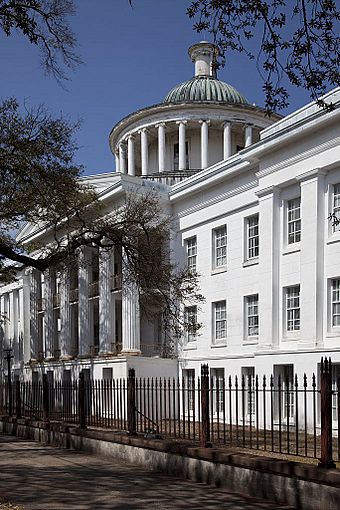Barton Academy facts for kids
Quick facts for kids |
|
|
Barton Academy
|
|

Front (south) elevation in 2010.
|
|
| Location | 504 Government Street Mobile, Alabama |
|---|---|
| Area | 1.8 acres (0.73 ha) |
| Built | 1836 |
| Architect | James Gallier, James H. Dakin and Charles B. Dakin |
| Architectural style | Greek Revival |
| NRHP reference No. | 70000107 |
| Added to NRHP | February 16, 1970 |
Barton Academy is a very old school building in Mobile, Alabama. It was built in a grand style called Greek Revival. Construction started in 1836 and finished in 1839. Famous architects like James H. Dakin and James Gallier, Sr. helped design it. This building was special because it was the very first public school in the state of Alabama!
Contents
The Story of Barton Academy
How the School Began
Barton Academy was named after Willoughby Barton. He was a state leader from Mobile. In 1826, he helped create Alabama's first school board. This board bought the land for the school in 1830. They paid $2,750 for the whole block.
Building the School
It was hard to get enough money to build the school. So, the state allowed the school board to raise money using a lottery. By 1836, they had collected $50,000 from the lottery. They also got a loan from the city and private gifts. A rich local man named Henry Hitchcock gave a lot of money.
Building started on February 13, 1836. Charles Dakin was in charge of the building work. The project was quite difficult. The roof was not built correctly at first. This caused water damage inside the building. But by the summer of 1837, the building was ready enough for meetings. The final touches were completed in January 1839.
Opening and Changes Over Time
After it was finished, Barton Academy was used by private schools. The school board helped fund these schools. In 1846, a new law allowed taxes to be collected. This helped create a free school.
By 1852, the building needed repairs. The board wanted to sell it, but the voters said no. A new school board was elected. They fixed the building. Barton Academy reopened as a public school in November 1852.
The school closed during the American Civil War. It reopened in 1865 for girls. Boys started attending in 1870. Both high schools stayed at Barton until Murphy High School opened in 1926. Barton Academy continued as a school until the 1960s. Then, it became the main office for the Mobile County Public School System. The building was added to the National Register of Historic Places in 1970. This means it's an important historic site.
What Barton Academy Looks Like
Building Style and Features
Barton Academy has three floors. It is mostly made of brick. The brick is covered with a special plaster to look like stone. The building has a strong ground floor. Above it are the main floor and a slightly smaller third floor.
In the middle of the building, there is a large porch with six tall columns. This is called a hexastyle Ionic portico. It has fancy iron railings. The roof over this part is low and flat. On top of the roof is a round dome. This dome has 28 small columns around it. A small tower, called a lantern, sits on top of the dome. It looks like an ancient Greek monument. On each side of the main part are simpler sections.
Inside the Building
Over the years, many changes have been made inside Barton Academy. So, it doesn't look much like it did when it was first built. Originally, it had a central staircase with classrooms on each side. The old wooden windows were replaced with metal ones. Only the round room under the dome still looks like it did in the beginning.
Saving Barton Academy
Efforts to Restore the Building
In 2005, the Alabama Historical Commission listed Barton Academy as a "Place in Peril." This means it was a historic site that needed help. The school board planned to move its offices. This meant the building might be neglected.
The school board moved its offices in 2007. They started working with groups to restore the building. But in 2009, the restoration work slowed down. The school board had already put $2.3 million towards fixing it. But some members didn't want to spend more money. They felt the money was needed for other parts of the school system. Because of this, Barton was again listed as a "Place in Peril" in 2009. People are still working to save this important piece of history.

